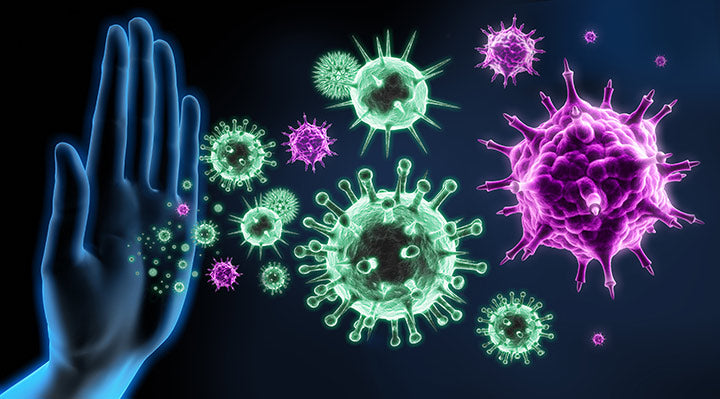Have you ever desired to have a superpower to protect you from all potential dangers? Well, if not from everything, your immunity can give you complete protection from different disease-causing agents. Hence, your immunity is no less than a superpower.
Now to understand how your immunity works, you need to know the different types and how they help your body to fend off diseases.
Let’s begin.
Highlights:
What Is Innate Immunity?

Innate immunity or natural immunity is your body’s first line of defence that helps fight against disease-causing organisms and prevents them from entering your body. This type of immunity is naturally found in your body since birth, It is non-specific, i.e, responds fast to any pathogen attack [1], and ensures lasting defense.
Innate immunity comprises different physical and chemical barriers that prevent pathogens from entering your body. [2] These include:
- Skin
- Mucus that traps bacteria
- Stomach acid
- Tears
Innate immunity is commonly present in almost every organism - whether it be skin or cell membrane. Upon breaking this barrier, your body initiates an inflammatory response such as fever, inflammation, etc.
Specific blood cells make histamines (a compound which is released by cells in response to injury) to help your body get rid of an allergen. However, it increases the blood flow in the affected area, eventually causing swelling.
Just when your body is able to identify any foreign body, it alerts neutrophils to fight them off. Usually the neutrophils of the infected area perish and the accumulation leads to pus. Phagocytes are also able to kill pathogenic organisms by the process of phagocytosis (ingestion of bacteria).
What Is Adaptive Immunity?
Adaptive immunity, also known as acquired immunity, stays true to its name. It is your second line of defence that comes into play if somehow the pathogens enter your body, evading your innate immunity. Adaptive immunity takes time to develop in your body when it is exposed to pathogens. It usually targets specific pathogens causing diseases.
Your active immune response first detects the pathogen and then creates immune cells to completely wipe off the pathogen from your body. It also creates memory cells [3] that remembers the specific pathogen and prevents it from re-attacking your body in the future.
Adaptive immunity can be classified under two heads – Active Immunity and Passive Immunity:
1. Active Immunity
Your body develops this type of immunity when it's exposed to different disease-causing agents. B cells in your body make antibodies to terminate the pathogen’s reaction in your body.
2. Passive Immunity
In this type of immunity, the source of antibodies is another person. For example, antibodies can be transferred to a new born baby through mother’s milk. It can also be developed in your body by artificial means, like injecting antibodies to combat diseases.
Adaptive immune system follows a two-way approach - humoral response and cell-mediated response to terminate the pathogens entering your body. In humoral response, as soon as your body identifies a foreign antigen, the B cells create antibodies to neutralize the effects and prevent it from infecting a cell.
In cell-mediated response, the pathogen-infected body cells are killed with the help of cytotoxic T cells.
What Are The Differences Between Innate Immunity And Adaptive Immunity?
|
Characteristics |
Innate Immunity |
Adaptive Immunity |
|
Source |
Naturally present in your body |
Acquired from a person or through vaccination |
|
Time Span |
Usually offers long term protection throughout your lifetime [4] |
May or may not last throughout your entire lifetime |
|
Response Time |
Immediate, usually within minutes or an hour |
May take 4-7 days or weeks |
|
Specificity |
Non-specific, does not respond differently to detected pathogens |
Pathogen-specific |
|
Inheritance |
Can be inherited from parents |
Cannot be inherited |
|
Cell Type |
Dendritic cells, Natural Killer cells, Macrophages, Eosinophils, etc. |
B cells, T cells, Antigen presenting cells etc. [5] |
|
Recognition |
Uses receptors to identify conserved molecular structures of bacteria, virus, or pathogens. These are called Pathogen Associated Molecular Patterns such as LPS, flagellin, etc. |
Uses recombined B and T-cell receptors that are able to recognize specific antigens (proteins) found on pathogens |
|
Molecules |
Cytokine |
Antibodies |
|
Immunological Memory |
No immunological memory |
Have long-term memory |
|
Activation |
Able to recognize pathogen-related patterns directly |
Requires help from other cells to recognize patterns and activate response |
Wrapping Up
There are significant differences between innate immunity and adaptive immunity. While innate immunity is naturally present in your body, adaptive immunity can be acquired from a person or through vaccination. Once you develop innate immunity in your body since birth, it usually gives you lifelong protection, whereas adaptive immunity can either give you long-term or short-term protection against infections.
1. https://cancerres.aacrjournals.org/content/canres/67/9/3989.full.pdf
2. https://medlineplus.gov/ency/article/000821.htm
3. https://www.ncbi.nlm.nih.gov/books/NBK279396/
4. https://www.cdc.gov/vaccines/vac-gen/immunity-types.htm
5. https://www.ars.usda.gov/research/publications/publication/?seqNo115=323699
Recommended Products
Was this Article helpful?
- Least helpful
- Most helpful











